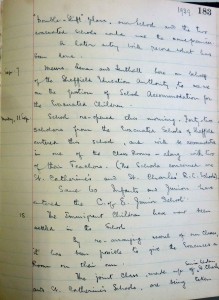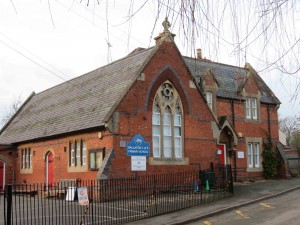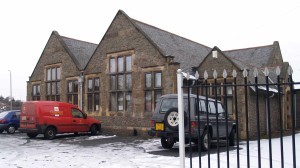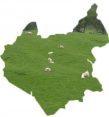The 20th century was a period of continual, and sometimes rapid, change. It is best considered in two stages, divided by the Second World War. The sources available for the study of schools in this period are listed together at the end of each section, and are in red.
Schools, 1902 – 1944
The establishment of county councils from 1888 created an opportunity for local government to become involved in educational administration, to improve standards and ensure local needs were met, particularly in respect of secondary education. In Leicestershire, a start had been made through the formation of a technical education committee by the county council in 1891. In 1902, under the terms of the Education Act of that year, the county council became one of three new local education authorities in Leicestershire (the others being Leicester and Loughborough borough councils). The LEAs had wide ranging powers to provide new buildings and set up new schools, and the obligation to provide education at two levels: elementary and ‘other than elementary’. They assumed responsibility for the board schools and any remaining British (non-denominational) schools. The Anglican church continued to have responsibility for providing and maintaining the buildings of its own schools, and providing the religious element of the teaching, but the LEAs met the cost of salaries for teaching secular subjects.
There was a wide gulf between urban and rural schools. Urban schools tended to be large, had modern buildings, were non-denominational, run by boards containing business people and offered a career structure to the best teachers from the training colleges. Some of the larger boards also sought to provide an advanced education to older children, although a court judgement of 1899 (the Cockerton judgement) had restricted their ability to do this. In contrast, rural schools often occupied older buildings, sometimes still of the single-room design. Partitioning was not necessarily practical, as many of these schools had just one teacher, perhaps with an unqualified pupil-teacher alongside. Most rural schools in Leicestershire were church schools, with no power to borrow, and were badly hit by the agricultural depression, which had reduced the incomes of their traditional benefactors of the parson and the parish’s major landowners. Even maintaining the buildings and providing the specialist equipment for the science teaching they were now obliged to deliver was a struggle.
The LEA could increase the pressure on schools to improve their premises, with additional classrooms, better sanitation, new heating systems and safer playgrounds. The government inspectors set the ball rolling, threatening to take away the grant, but the LEA could reinforce this through the ‘threat’ of a new council school if a voluntary school seemed reluctant to comply. Trying to raise money when there was no certainty that another demand would not follow the next year was not easy, and some gave up the struggle. Opponents to council schools based their arguments on religious ethos and also cost, and many feared increased rates to pay for a building that might be of a higher standard than was strictly necessary. The new council school built at Castle Donington to replace the Wesleyan and Anglican day schools is a case in point. With the council seemingly determined to build a school large enough for all the children, the Anglican managers thought it futile to resist, even though the improvements required to their school would cost £770 and the new school would cost around five times that sum. And what a school it was! The new council school was completed in 1910, had the words ‘County Council Schools’ emblazoned across the front and had elaborately carved stone pediments over all the doors to the front and sides (see photograph).
In the Leicestershire coalfield area, the issue was not one of poor quality buildings, but of insufficient school places. Rapid population growth had not been matched by the provision of new schools.
In other places perfectly good schools were competing with each other for pupils, creating inefficiencies. The LEA made various proposals, so church and non-church schools catered exclusively for different age groups, but it restricted parent choice, and the managers of the school that would take the younger children could feel slighted. In some places, goodwill saw the changes accepted easily, while in others it was more of a struggle.
Endowed schools faced similar problems to the voluntary schools, as their endowments were often invested in land, so their income fell. Private schools met some of the increasing demand for more advanced education, at least initially, but their days were becoming numbered. Regulations introduced in 1907 required that all private schools teaching children over the age of 11 had to make one quarter of their places available free of charge to children who had attended a public elementary school and who passed an entrance examination (the forerunner of the 11-plus). The middle classes, whose children had previously attended private schools, started to send their children to church or council elementary schools (originally intended for the poor) until they reached 11, to enable them to compete for a scholarship place. To curb the impact of this, means testing was introduced for scholarships from 1931.
The 1918 Education Act obliged LEAs to make provision for children who remained at school beyond the leaving age, which was raised to 14 in 1921. Some reorganisation became essential, both in terms of additional accommodation for two more year groups and because in small rural schools it was virtually impossible for one teacher to provide adequate teaching for them all.
The Hadow Report of 1926, The Education of the Adolescent, proposed that children should commence their education in a ‘primary’ school, and transfer to a ‘secondary’ school at the age of 11, to continue their education to the school leaving age or beyond. A number of different types of secondary schools were suggested, triggering a similar debate to that seen in the 1870s when endowed schools were reformed, about whether any child should be able to attend any type of senior school. Each secondary school would need to cover a wide geographic area, and decisions had to be made about the distance children could be expected to travel, and how they would get there.
Leicestershire LEA carried out a survey of the county’s small schools in 1903-4, and reconsidered possible economies again in 1922. Rural schools came under the spotlight again in the 1930s, and a report of Leicestershire’s 152 schools with fewer than 100 pupils was published in July 1933. Lowesby Church of England school, with just 11 pupils, was the smallest in the county, but closure was thought impractical, because of the journey a bus would have to make to take the children to another village. It remained open until the end of the summer term 1974 when, with just 6 children on the books, the decision was made that it would close.
Many Leicestershire schools accepted evacuees during World War II, some of whom arrived two days before Britain declared war. Precautions to safeguard the children were also taken, with blackout curtains erected, secure areas created and in some cases bomb shelters were provided.

Sources for the history of schools, 1902-44
- Minutes of school managers’ or governors’ meetings.
- School log books
- Programmes from school openings
- Ephemera, such as photographs
- Newspaper reports
- Trade Directories
- Oral history (including many recordings within the East Midlands Oral History Archive)
- County Council records and LEA minutes, which may contain information relating to individual schools and also architect’s plans.
- Leicestershire County Council Education Committee Survey of Small Schools and Departments, July 1933 (ROLLR, DE 3528/6)
- School and parish files held at The National Archives, which will give details of matters that were referred to central government, for example by the school inspectors. These can include details of arrangements made when a teacher volunteered to serve in the First World War.
- National Society school files, held at Lambeth Palace Library
- The Hadow Report includes a summary of ‘secondary’ provision at that date within the borough of Leicester (at p. 61).
Note: Records created by individual schools may be at the Record Office for Leicestershire, Leicester and Rutland, or still held by the school. Other than records which identify individual pupils, they should normally be open to inspection 30 years from the last entry they contain.
Education since 1944
The Spens report of 1938 proposed three types of secondary education: grammar, ‘modern’ and technical, but war intervened before changes were made. The 1944 Education Act gave new powers to the LEAs, which were required to draw up a development plan for their area. Most chose to divide primary education into infant and junior schools, and create a three-tier system for secondary education of grammar, secondary modern and technical schools, in line with the Spens recommendations, although in practice few technical schools were opened. New grammar schools were provided, with children selected for them at the age of 11 by an examination. State grants to grammar schools continued, under revised terms.
Church schools continued, but had to choose between being ‘voluntary aided’ or ‘voluntary controlled’. Most choose the latter route, limiting the church (or other body) to the appointment of only a minority of the governors, ceding control in exchange for full funding. A few Leicestershire primary schools chose to be (and some remain) ‘voluntary aided’, where a foundation (such as the church) owns the building, appoints a majority of the governors, but also has to contribute to the school’s capital costs. The 1944 Act also raised the school leaving age to 15, secondary education became free for all pupils and the pupil-teacher apprenticeship system was abolished, so all future teachers would have to attend one of the training colleges.

The provision of free secondary education turned attention again to the remaining endowed schools. Even after the reforms which got underway in the 1870s, there were still a large number of educational charities, and many of these had either been grammar schools since their creation or had been providing a free secondary education since the 1870s reforms. What was to be their role now the state was providing free secondary schooling? The government wished to merge and group these charities to cut administrative costs and to provide flexibility. New schemes were drawn up for the county’s endowed schools, sometimes diverting the endowment income to books and scientific equipment.
Within a decade of the 1944 Act concerns were mounting about selection for a specific type of secondary education at the age of 11. In April 1957 Leicestershire LEA adopted the ‘Leicestershire Experiment’, later more tactfully renamed the ‘Leicestershire Plan’. In two areas of the county, Oadby/Wigston and Hinckley, the 11+ examination would be abandoned, with all children transferring to local high schools at the age of 11. After three years, those children whose parents undertook to keep their children at school until the age of 16 transferred to a single grammar school for the area, while the others remained in the high school until they reached the school leaving age of 15. Changes of school were not linked to any examination, and a comprehensive system could be created without the immediate need for larger buildings. It was considered an ideal ‘solution’ to the perceived disadvantages of the 11+ in a period when there was little money for new building projects. By 1969 the plan had been rolled out across the whole county, making Leicestershire the first county to become fully comprehensive. When the school leaving age was raised to 16 in 1972, all children transferred to the upper school after three years in a high school.

New primary schools were built, as a result of the post-war ‘baby-boom’ and the need to modernise the building stock. New building got underway in the 1950s and continued throughout the 1960s. Many of the old Victorian schools were replaced by modern schools, with assembly halls, smaller classrooms, modern heating and larger grassed playing fields replacing small yards. Groby provides a good example of the continuing need for additional schools, in this case following the sale in 1925 of what was once an estate village. The school erected by the Countess of Stamford and Warrington in 1873 was taken over by the county council in 1905, but in 1907 a new, larger, school was provided by the council on a neighbouring site. These sufficed until the 1950s. New housing estates and rapid population growth since then has resulted in the replacement of these buildings with five new schools: three primary schools for a total of 600 pupils, a high school and an upper school/community college. Other villages have contracted, and some of Leicestershire’s village schools have been closed, as the number of their pupils fell.
The county also led the way in innovative school design, being among the first to build schools with rooms clustered around a central area.
In August 1970, further change was introduced in three areas: Castle Donington, Shepshed and Bottesford. Infants and juniors would be merged to form a single primary school for children aged 5-10. They would then transfer to high school at age 10 for a four-year course. At the end of their 9th year at school, they would transfer to an upper school, in line with the original Leicestershire plan. This revision was not adopted throughout the county, but on an area by area basis, taking into account the size of schools and distance between them.
In more recent years, the number of different types of school has multiplied. Specialist secondary schools were introduced in 1993, initially for technology, but soon for other subjects, such as languages and sports. Self-governing academies were introduced in 2000 and, freed from local authority restrictions, are able to set the age range of their pupils. Many schools have converted, or are converting, to academy status, giving parents a whole range of options to consider for their children.
Sources for the history of schools since 1944
- The sources listed above for the early 20th century remain relevant. Two issues arise with these: the sheer quantity of documentation that survives, including the smallest details, and the 30-year closure period for some types of record.
- The County Council’s website includes details of age ranges for schools and their catchment areas.
- Inspections: the most recent Ofsted report is available online
- For Anglican schools, the files at Lambeth Palace Library include diocesan inspection reports
- Most schools have websites, and although these are mostly geared towards the type of things that parents want to know, a few provide information about the school’s history and most include contact details for the school secretary.
- Oral history (whether formally recorded, or just a chat with local people) can be very helpful
